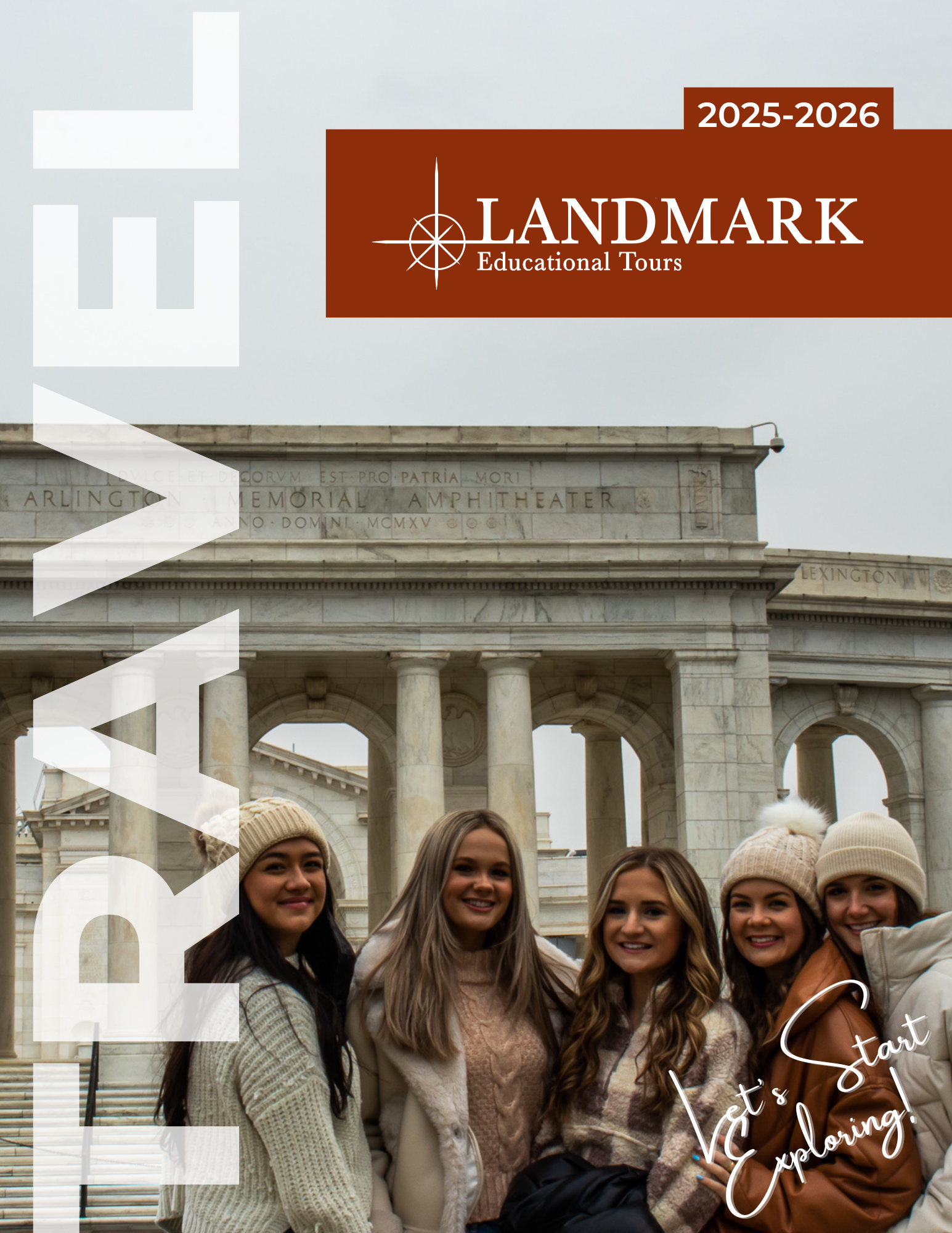Educational Highlights of School Trips to NYC
Ever wondered how a school trip to the Big Apple could enrich your students’ learning? This post unpacks the educational treasures New York City offers, from soaking in history on the streets of Manhattan to engaging with cutting-edge science at interactive centers. Teachers planning such an excursion face the challenge of maximizing educational value amidst an overwhelming array of choices. Here, we’ll highlight the standout experiences in history, art, and culture that promise to ignite students’ curiosity and complement classroom learning, ensuring your next NYC school trip is not only memorable but also profoundly educational.
Explore the Rich History of New York City
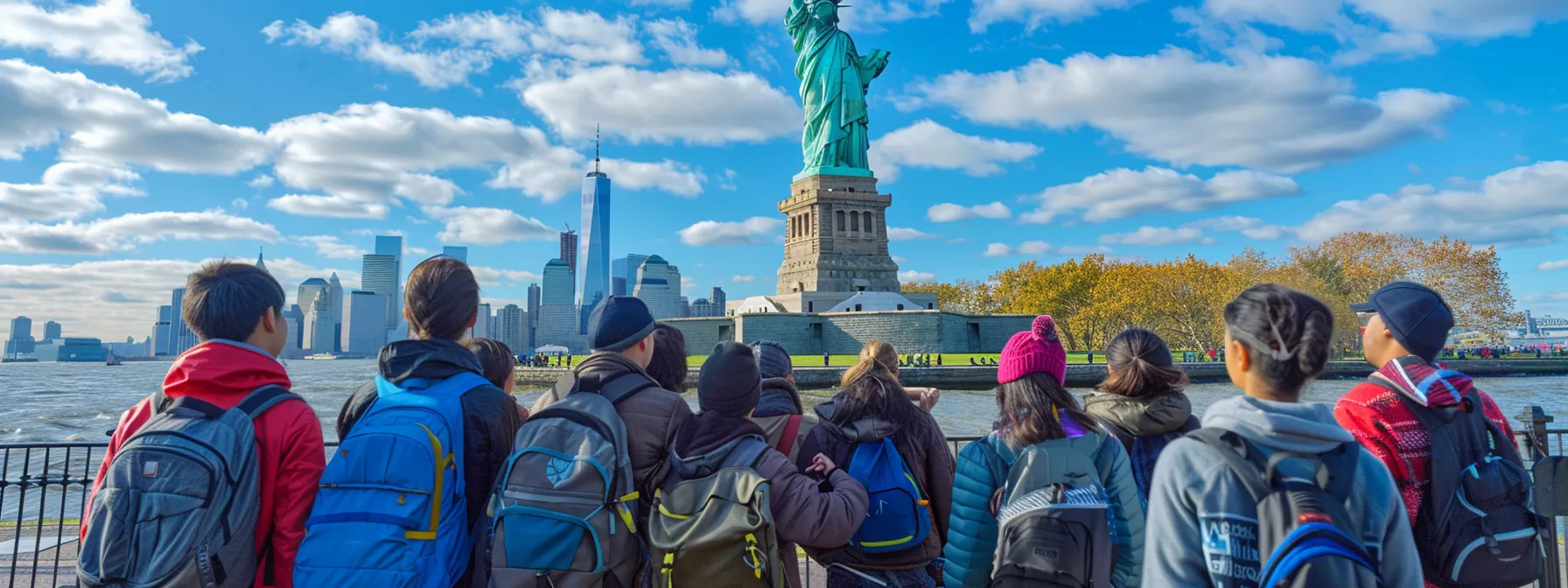
Taking students on an educational journey through New York City’s historical sites enriches any school trip itinerary. Learners can step back in time at the Lower East Side Tenement Museum, trace the paths of ancestors at the Ellis Island Immigration Museum, and reflect on recent history at the 9/11 Memorial. They’ll delve into the Revolutionary past at Fraunces Tavern Museum, and celebrate African American culture in Harlem. Each location offers a unique educational perspective, vital for broadening young minds on student trips, especially those from performing arts schools seeking inspiration performing arts school trip.
Walk Through Time at the Lower East Side Tenement Museum
A visit to the Lower East Side Tenement Museum offers students a powerful glimpse into the everyday lives of immigrants who built their homes in New York City over a century ago. The museum’s restored apartments and detailed exhibits allow students to understand the challenges and triumphs faced by early urban dwellers, connecting past experiences to the present day’s diverse landscape.
Guided tours at the Tenement Museum provide an immersive experience, transporting student groups back to the 19th and 20th centuries. As they walk through historical recreations, they’re encouraged to engage with the stories of hope, hardship, and resilience, fostering a deep appreciation for the city’s rich cultural tapestry.
Uncover the Stories at Ellis Island Immigration Museum
When student groups stand in the halls of the Ellis Island Immigration Museum, they are walking through the gateway many American ancestors passed. The museum’s compelling exhibits tell a story of perseverance and aspiration that resonates today, teaching valuable lessons about the formation of the country’s cultural melting pot. Students have the opportunity to explore passenger records and discover personal tales that give a human face to the larger narrative of migration.
The interactive displays and firsthand accounts allow learners to connect with history on an intimate level. In experiencing the Ellis Island Immigration Museum, students not only learn about the immigrant experience from decades past but also gain perspective on the ongoing discussions surrounding immigration in the United States. It’s this kind of hands-on learning that can spark curiosity and empathy, contributing to a more comprehensive understanding of American history.
Visit the 9/11 Memorial and Understand Its Impact
As students stand before the 9/11 Memorial, they’re enveloped by a solemn tribute to resilience and remembrance. The powerful design captures the magnitude of loss while fostering reflection on the global impact of that fateful day. The twin reflecting pools, inscribed with the names of those who perished, serve as poignant educational tools to discuss themes of sacrifice, recovery, and collective memory.
Exploring the 9/11 Memorial offers a profound connection to contemporary history and its lasting effects on both local and international communities. Through this visit, teachers can guide meaningful discussions on conflict resolution, peace-building, and the importance of global citizenship: the surrounding exhibits and survivor stories provide authentic insights for student visitors, encouraging them to contribute thoughtfully to conversations about 9/11 and its aftermath.
| Experience | Educational Value | Themes for Discussion |
|---|---|---|
| 9/11 Memorial Pools | Personal impact, Historical significance | Sacrifice, Recovery |
| Survivor Stories | Authentic Insights, Contemporary relevance | Resilience, Global Citizenship |
Learn About Revolutionary History at Fraunces Tavern Museum
Stepping into Fraunces Tavern Museum, one is instantly transported to the revolutionary era where colonial New York comes to life. This historic site, where George Washington bid farewell to his officers, now serves as a thrilling educational space for students to grasp the challenges and strategies of America’s fight for independence. With authentic artifacts and engaging storytelling, pupils gain a deeper understanding of the Revolutionary War, fostering a connection to the nation’s foundational history.
The museum not only showcases 18th-century life with its period rooms and colonial art collections, but it also prompts young learners to consider the complexities of war and governance. By examining original documents and participating in interactive exhibits, students critically think about the roots of American democracy and its enduring impact. They leave with greater insight into how past leaders shaped the principles that continue to guide the country.
Discover African American Heritage in Harlem
Harlem stands as a vibrant cradle of African American culture, making it an essential stop for education-focused school trips to New York City. Students are introduced to the legacy of the Harlem Renaissance as they visit landmarks such as the Apollo Theater and the National Jazz Museum, learning about the pivotal figures like Langston Hughes and Ella Fitzgerald who propelled African American artistry onto the world stage.
Teachers can enrich the students’ cultural literacy by incorporating visits to the Schomburg Center for Research in Black Culture, where research and exhibits delve into the complexities of black history and its global influence. The interactive learning opportunities in Harlem encourage students to appreciate the contributions of African Americans to literature, music, and the ongoing pursuit of civil rights:
| Landmark | Cultural Significance | Key Figures |
|---|---|---|
| Apollo Theater | Musical innovation, Performance history | Ella Fitzgerald, Duke Ellington |
| Schomburg Center | Historical Research, Cultural Preservation | Arturo Alfonso Schomburg, Malcolm X |
New York’s history whispers through its cobblestone streets and towering skyscrapers. Now, step inside the city’s hallowed halls where art and culture collide magnificently.
Discover World-Class Museums and Art Galleries

New York City is a treasure trove for young minds, and its renowned museums and art galleries are central to any educational visit. From the timeless pieces at the Metropolitan Museum of Art to the imaginative spaces of the Museum of Modern Art, students discover a world of creativity and history. The American Museum of Natural History offers a walk through the wonders of science, while the Children’s Museum of Manhattan engages with hands-on learning. Not to be missed, the spiraling galleries of the Guggenheim Museum immerse students in contemporary art, rounding out an enriching cultural experience.
Explore Masterpieces at the Metropolitan Museum of Art
The Metropolitan Museum of Art, affectionately known as ‘The Met’, offers students on school trips an unforgettable foray into global cultures and histories. This iconic New York institution houses over two million works, spanning 5,000 years of world tradition and creativity. Whether studying ancient Egyptian artifacts or marveling at European masterpieces, learners encounter an array of educational experiences tailored to deepen their understanding of art and history.
In the grand halls of The Met, student groups engage directly with art that has shaped civilizations. Teachers can focus on specific collections, such as the American Wing or the collection of Greek and Roman art, to complement their curriculum: the museum’s extensive resources encourage dynamic learning, sparking curiosity and discussion among young visitors.
| Collection | Subject Focus | Educational Opportunities |
|---|---|---|
| American Wing | American history, art | Exploration of cultural identity, discussion of historical influences on art |
| Greek and Roman Art | Classical civilizations, mythology | Connection to ancient cultures, insights into societal values through art |
Engage With Modern Art at the Museum of Modern Art
The Museum of Modern Art, known affectionately as MoMA, is a playground of creativity and exploration that beckons student groups in New York City. Here, young art enthusiasts can come face-to-face with revolutionary works by van Gogh, Warhol, and Picasso, triggering lively discussions on art movements, expression, and the impact of modernism.
Teachers find MoMA’s rich array of interactive workshops and curated exhibits invaluable for nurturing students’ appreciation for contemporary art and visual literacy. The museum’s commitment to education shines through programs designed to highlight the connections between art and society, providing students with a unique lens to view and interpret the ever-changing world around them.
Visit the American Museum of Natural History’s Exhibits
The American Museum of Natural History is an adventure waiting to happen for any student group visiting New York City. With exhibits ranging from the age of the dinosaurs to the depths of the ocean, it’s a place where curiosity is piqued and the thirst for knowledge grows exponentially. Students can see the 94-foot-long blue whale model and feel like marine biologists for a day, or stand under the towering skeleton of a T. rex and marvel at the ancient world of the Cretaceous period.
It’s at the museum’s immersive dioramas and interactive displays where lessons leap out from textbook pages into real life. One finds young learners animatedly discussing the evolutionary adaptations of mammals in the Hall of Biodiversity, or solving the mysteries of the universe at the Rose Center for Earth and Space. These experiences not only contribute to their scientific knowledge but also encourage critical thinking and wonder about the natural world.
Experience Interactive Exhibits at the Children’s Museum of Manhattan
The Children’s Museum of Manhattan turns learning into an adventure with its hands-on exhibits that spark the imagination of young explorers. Here, student groups can dive into interactive play areas that are both fun and educational, covering topics from environmental science to cultural awareness.
Teachers love how the museum’s exhibits, such as the ‘Dynamic H2O’ and ‘EatSleepPlay’, seamlessly merge learning with play, ensuring students absorb valuable lessons without even realizing it. The activities are specially designed to cater to a child’s natural curiosity and the desire to touch, move, and interact, making the Children’s Museum of Manhattan a highlight for any school group visiting NYC.
Dive Into Contemporary Art at the Guggenheim Museum
The Guggenheim Museum is not merely an art space; it’s a symbol of innovation and contemporary design. Here, students witness cutting-edge exhibitions that stretch the boundaries of traditional art, offering a transformative experience. The museum’s spiral layout, a work of art in itself, invites learners to wind their way through galleries, engaging with complex concepts and visual dialogues that shape the art world today.
Within the Guggenheim’s famed walls, student groups uncover the pulse of the present art scene. They come into contact with stirring collections that showcase a variety of mediums and styles, from minimalism to conceptual art. This interaction not only sharpens a student’s critical thinking about the zeitgeist of our times but also ignites conversations around creativity’s role in societal evolution.
From the silent stories told by ancient artifacts to the expressive canvases that capture time, museums offer a visual feast. But just a step away, the vibrancy of Broadway awaits, where live performances bring stories to thrilling life.
Experience the Performing Arts on Broadway
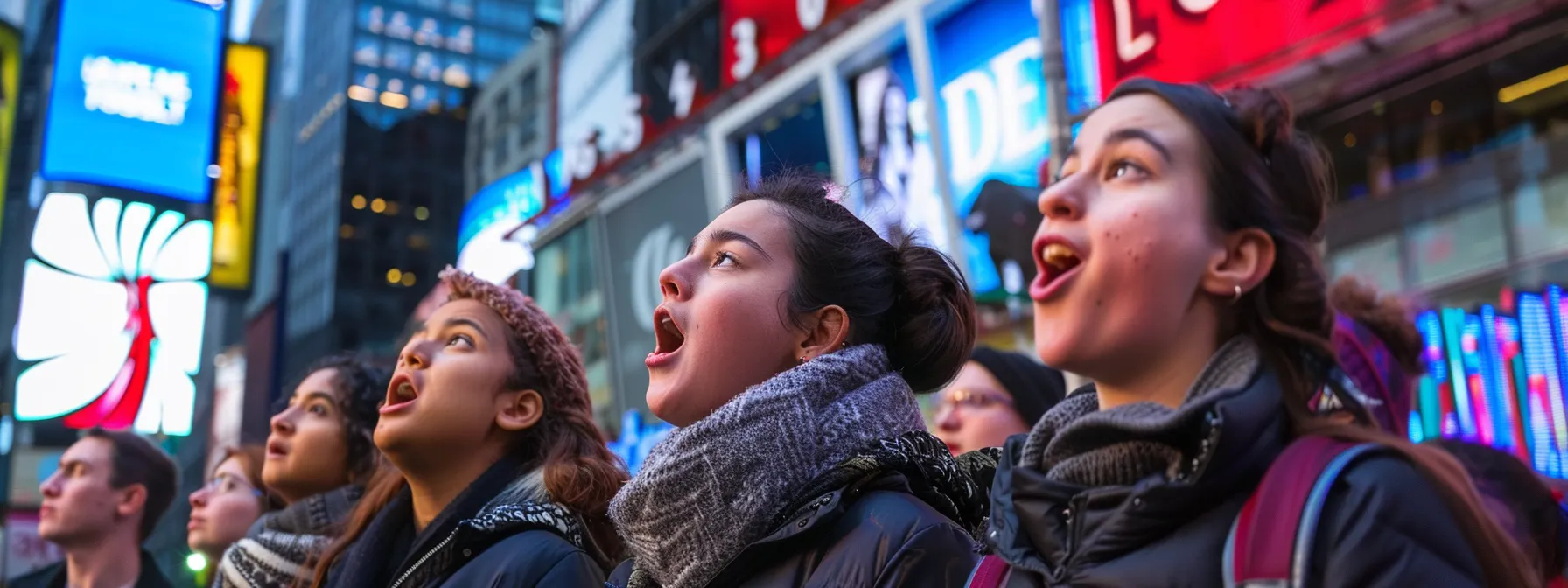
On School Trips to NYC, students can immerse themselves in the city’s vibrant performing arts scene. They’ll not only get the chance to attend a memorable Broadway musical but also participate in enriching theatre workshops and go behind the scenes on exclusive tours. Additionally, the Drama Book Shop offers a deep dive into the history of theater, while the energy of Times Square allows students to engage with street performers. For a classic twist, exploring ‘Shakespeare in the Park’ performances provides a unique outdoor theatrical experience.
Attend a Broadway Musical for an Unforgettable Experience
There’s nothing quite like the exhilaration of attending a Broadway musical to make a school trip to New York City truly standout. Students not only get to witness the pinnacle of American theater but also to absorb the rich storytelling and cultural significance each production holds. In the glow of the stage lights, the drama, humor, and talent converge to create a memorable educational encounter—one that often leaves students with a lasting appreciation for the performing arts.
During a Broadway show, the combination of live performance, intricate set designs, and musical scores provide a dynamic learning experience. This hands-on exposure to the arts sparks students’ creativity and can even influence future academic interests or career pursuits. Teachers find these performances particularly valuable as they offer tangible examples of how dedication and collaboration come together to achieve artistic excellence.
Participate in Theatre Workshops and Behind-the-Scenes Tours
When students participate in theatre workshops on a New York City school trip, they’re not just passive observers; they become an active part of the city’s famed Broadway scene. These workshops offer practical insights into the performing arts, from acting techniques to stage production, giving students a hands-on experience that can ignite a passion for theater. Teachers see the immediate benefits as their students grow in confidence, develop new skills, and understand the intricate teamwork involved in putting on a Broadway show.
Behind-the-scenes tours complement classroom learning by allowing students to uncover the magic that brings a Broadway production to life. They catch glimpses of costume design, set construction, and the technical wizardry that goes on backstage, gaining an enhanced appreciation for the professionals who create these magnificent shows. For students, these insights demystify the stage and open their minds to potential careers in the arts:
- Understanding the roles behind the curtain
- Appreciating the skill of set and lighting design
- Exploring career opportunities in stage management and production
Learn About the History of Theater at the Drama Book Shop
For student groups captivated by the allure of the stage, the Drama Book Shop is a hidden gem in the heart of New York City’s theatre district. This storied establishment invites the curious to explore the vast collection of play scripts, theatrical reference materials, and books on the performing arts, creating a tangible link to the history of theater. It’s a place where learners can connect the dots between past performances and contemporary shows, enhancing their grasp of theatrical tradition and innovation.
The shop also acts as a cultural hub, offering a cozy spot for students to discuss the nuances of dramatic literature or perhaps even stumble upon a workshop with theater professionals. Experiences like these enrich their understanding of the dramatic arts and inspire a profound respect for the intricacies of stagecraft and its evolution. For teachers, it’s a practical venue that infuses historical context with hands-on learning, perfect for nurturing future thespians or avid theatergoers.
Engage With Street Performers in Times Square
Times Square thrums with the pulse of New York City, and for students, the opportunity to interact with street performers here is unparalleled. The diverse array of talent—from musicians and dancers to living statues and magicians—turns this bustling crossroads into a live, open-air theater. The energy and spontaneity of these performances offer students real-world insight into the performing arts, demonstrating the accessibility and communal nature of this creative expression.
Teachers observe how these encounters can inspire students, highlighting the importance of perseverance and public engagement in the arts. Engaging with the street performers provides not only entertainment but also a moment for students to appreciate the hustle and dedication required to thrive in NYC’s vibrant artistic landscape. These vivid experiences spark conversations about artistic career paths and the value of audience connection, making Times Square an educational and electrifying stop on any Broadway-focused school trip.
Explore Shakespeare in the Park Performances
When students sit under the stars at Shakespeare in the Park, they connect with the Bard’s timeless works in an inviting, real-world classroom. The public performances, set against the backdrop of Central Park, offer a memorable way for students to experience literary classics like ‘Macbeth’ or ‘A Midsummer Night’s Dream’. For many, the opportunity to see Shakespeare’s narratives unfold on stage fosters a newfound appreciation for the plays’ complex characters and enduring themes.
Shakespeare in the Park doesn’t just entertain; it creates a dynamic learning environment where dialogue and action leap from the page to the stage. Teacher-led discussions after the show can deepen understanding of Elizabethan language, historical context, and the universal human experiences Shakespeare masterfully captures. It’s this immersive approach to teaching Shakespeare that can ignite a passion for literature, encouraging students to explore the intersection of performance and poetic storytelling.
The magic of Broadway reverberates long after the final curtain call. Just beyond the theater doors, the city’s pulse leads us to streets lined with timeless structures waiting to tell their tales.
Visit Iconic Landmarks and Architectural Marvels
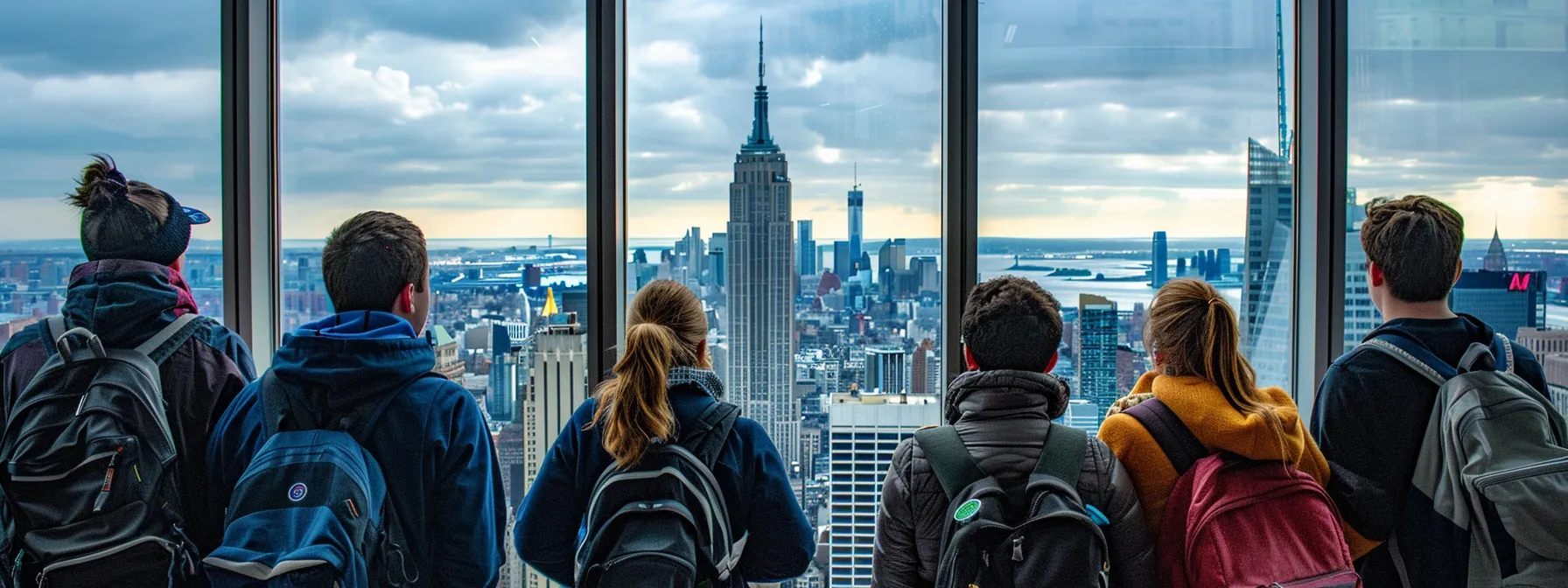
School trips to New York City are enhanced by visiting landmarks that tower over the cityscape and those embedded in its rich history. Ascending the Empire State Building, students gain a sky-high perspective on urban geography. Tours of the Statue of Liberty and Ellis Island offer tangible links to America’s heritage, while the Brooklyn Bridge provides a sunset canvas for conversations on engineering feats. The grandeur of Grand Central Terminal showcases the city’s architectural prowess, and a stroll on the High Line reveals a modern twist on urban revitalization.
Climb to the Top of the Empire State Building for City Views
For an educational school trip to New York City that reaches new heights, there’s nothing like a visit to the Empire State Building. Students can ascend to the building’s observatory decks and be rewarded with a sweeping 360-degree view of the city’s skyline and beyond. This experience not only captivates with its breadth but also enriches geography lessons with a bird’s-eye view of urban planning and landmarks.
The Empire State Building serves as a towering classroom, where students can learn about architectural engineering, the history of skyscrapers, and the role of innovation in urban development. Standing atop this emblematic structure, learners gain a clearer understanding of New York City’s layout and the massive scale of human achievement in construction:
- Decoding the story of skyscrapers
- Observing the effects of urban planning
- Understanding the innovations in building design
Take a Guided Tour of the Statue of Liberty and Ellis Island
A guided tour of the Statue of Liberty and Ellis Island turns pages of history textbooks into vivid, real-life experiences for students. They’ll stand face-to-face with Lady Liberty, a global symbol of freedom and democracy, soaking in the profound impact she’s had on millions seeking a new start in America. Teachers can point out the statue’s unique aspects, such as the seven spikes on her crown representing the world’s seven oceans, linking discussions to geography and social studies with tangible examples.
Over at Ellis Island, students will explore the rooms where immigrants once waited with a mix of hope and anxiety, a powerful reminder of the country’s diverse roots. They’ll have the chance to examine archival records and maybe trace connections to their own family histories, bringing a personal touch to learning about the nation’s immigration saga. These tours don’t just narrate stories; they let students step into the shoes of those who came before, giving context to the current conversations about immigration and cultural identity.
Walk Across the Historic Brooklyn Bridge at Sunset
As the sun dips lower in the sky, the Brooklyn Bridge offers a stunning classroom without walls for student groups in New York City. Bathed in golden hues, the bridge’s intricate lattice of cables and Gothic stone arches become a backdrop for lessons in engineering and architecture. Students can decode the design principles of John A. Roebling and imbue their understanding of suspension bridges with the first-hand sight of this iconic structure.
Walking across the Brooklyn Bridge at sunset is not just an exercise in history; it fosters discussions on urban development and the significance of connecting boroughs to sustain a growing city. Teachers will find it to be the perfect moment for students to reflect on the progress forged through innovation, as the Manhattan skyline emerges like a lesson in perseverance and ambition against the evening sky.
Admire the Architecture of Grand Central Terminal
Grand Central Terminal stands as an architectural masterpiece, a broad canvas for students to appreciate the grandeur of early 20th-century design. When students gaze at the celestial ceiling in the Main Concourse, dotted with constellations and golden zodiac signs, they connect with an age when art and architecture merged seamlessly, turning public spaces into galleries.
Each marble staircase, brass clock, and the whispering gallery within Grand Central tells a story of New York’s history and ambition. A school trip here enlightens young minds about urban innovation, the importance of transportation in city life, and the indelible impression of classic Beaux-Arts style on a bustling modern society.
Explore the High Line, an Elevated Urban Park
As school groups step onto the verdant walkways of the High Line, they’re greeted by a fusion of nature and urban design. This elevated park, built on a historic freight rail line, provides a refreshing escape nestled in the city’s fabric. Students can engage with the concepts of sustainability and urban reimagination as they stroll past gardens, art installations, and panoramic city views. The High Line’s story is a testament to community vision and renewal, making it an inspiring example for budding environmentalists and city planners alike.
Teachers find the High Line to be an open-air classroom where lessons in horticulture, architecture, and urban planning come to life. Everyday elements like the park’s water-efficient landscaping and repurposed rail tracks highlight innovative design solutions: students are guided to appreciate the intersection of history and modernity, demonstrating that progress doesn’t have to come at the expense of preservation or green space.
- Observing sustainable park design and its impact on city life
- Understanding the High Line’s role in preserving Manhattan’s history
- Encouraging discussions about transforming urban spaces into green environments
After marveling at New York’s grand edifices, it’s time to step into the future. Embrace the hands-on discovery that awaits at the city’s hubs of science and technology.
Engage in Science and Technology at NYC’s Interactive Centers
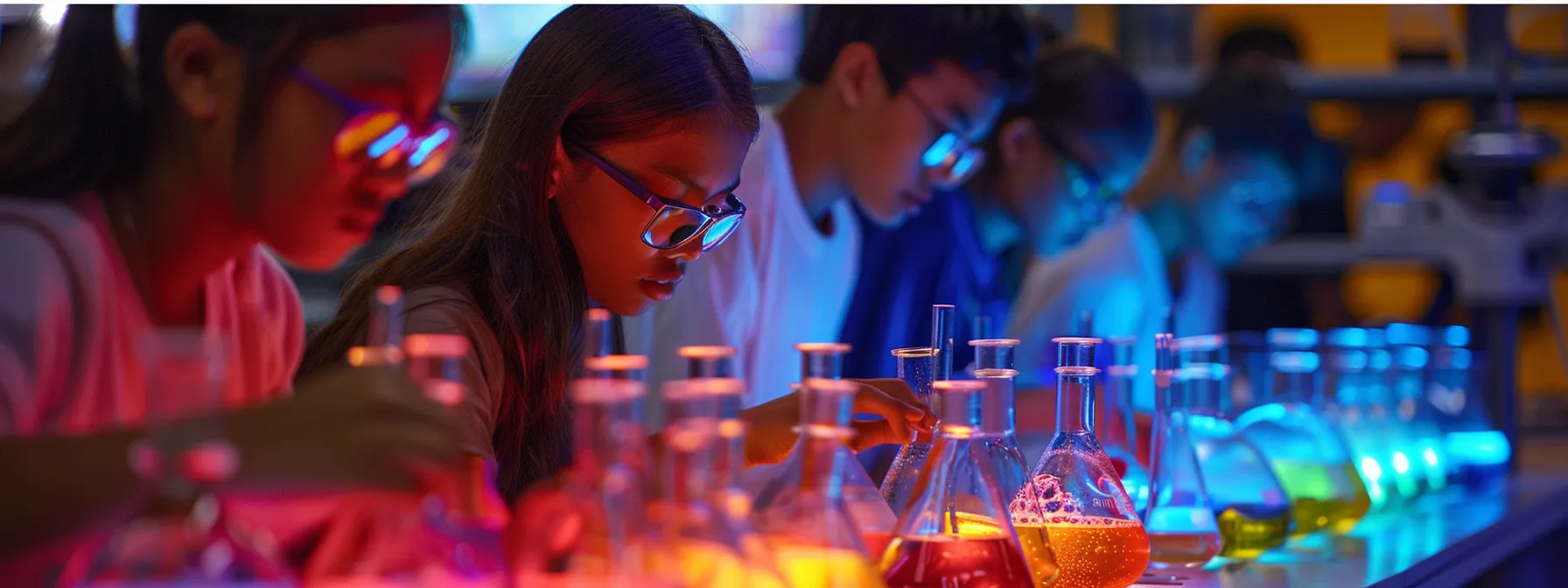
Students on New York City school trips have unique opportunities to dive into the worlds of science and technology. Engaging workshops at the New York Hall of Science build hands-on skills while the Intrepid Sea, Air & Space Museum opens up the cosmos. Innovative ideas come alive at the Sony Wonder Technology Lab, and the Queens Botanical Garden is a living lab for environmental science. Not to be missed, the American Museum of Mathematics turns numbers into interactive fun. These experiences enrich science education and inspire the innovators of tomorrow.
Participate in Workshops at the New York Hall of Science
When student groups visit the New York Hall of Science, they immerse themselves in an interactive learning environment brimming with hands-on science workshops. These sessions, ranging from robotics to kitchen chemistry, make the principles of STEM subjects tangible and exciting, fostering a love for science in a way that textbooks alone seldom achieve.
The educators at the Hall of Science are adept at translating complex concepts into engaging activities that capture students’ imaginations. Their interactive exhibits, like the live demonstrations of physics or the Design Lab where students can create and experiment, turn abstract ideas into concrete understanding, bridging the gap between theory and real-world application.
Explore Space at the Intrepid Sea, Air & Space Museum
At the Intrepid Sea, Air & Space Museum, student groups have the universe at their fingertips. The Space Shuttle Pavilion, home to the Enterprise, draws visitors into the core of historic space exploration efforts. This hands-on approach allows learners to delve into the intricacies of spacecraft engineering and the physics of space travel, bringing abstract concepts down to Earth.
The museum also honors the achievements and bravery of astronauts with its immersive displays. Students examine original artifacts and learn about the vital role science and technology have played in propelling humanity beyond our planet. Exhibits on the Mercury and Gemini missions, as well as discussions on the future of space exploration, cultivate aspirations among young space enthusiasts:
- Touching actual space shuttle tiles
- Exploring the inside of a replicated Mercury capsule
- Understanding the rigors of living in space
Discover New Technologies at the Sony Wonder Tech Lab
The Sony Wonder Technology Lab in New York City provides an interactive showcase of technological innovation and digital entertainment, capturing the imagination of student groups. In this dynamic space, students get hands-on with the latest in software development, robotics and media production, tapping into the pulse of the tech industry.
With exhibits that invite experimentation and collaboration, the Sony Wonder Technology Lab unlocks a new level of digital literacy for future innovators. By engaging with state-of-the-art gadgets and technology in a fun, accessible way, students leave with a grasp of how these tools shape our communication, work, and leisure.
Engage With Environmental Science at Queens Botanical Garden
Queens Botanical Garden is New York City’s living classroom for environmental science, offering immersive encounters with nature that engage student groups on their educational journey. Visitors explore habitats that model sustainability, from fragrant herb gardens to thriving wetlands, enhancing their environmental awareness and stewardship. Each section of the garden serves as an interactive platform, fostering discussions about ecological balance and the importance of biodiversity.
While wandering among the blossoms and greenery, students witness conservation practices firsthand, from rainwater harvesting to composting methods. The garden’s programs often include hands-on activities that instill a passion for protecting the environment, empowering learners to think critically about their role in a sustainable future. The tangible lessons gleaned here resonate long after students return to their classrooms:
| Environment Feature | Conservation Practice | Educational Focus |
|---|---|---|
| Rain Gardens | Stormwater management | Water conservation, Urban sustainability |
| Composting Site | Waste reduction | Soil health, Renewable practices |
| Wetland Area | Habitat restoration | Biodiversity, Ecosystem services |
Visit the American Museum of Mathematics for Hands-on Learning
The American Museum of Mathematics, often referred to as MoMath, transforms the abstract world of numbers into an engaging, interactive experience for students on NYC school trips. Its innovative exhibits and dynamic workshops give learners a chance to grapple with mathematical concepts through fun and play, thoroughly dispelling the myth that math isn’t thrilling. By fostering this hands-on engagement, students often leave with a newfound excitement for a subject that once seemed daunting.
MoMath’s interactive features, like the square-wheeled tricycle and laser-cut puzzles, illustrate complex principles such as geometry and topology in ways that directly connect to students’ natural curiosity. This approach turns the learning process into a journey of discovery, reinforcing the practical application of maths in everyday life and possibly even sparking future academic interests in STEM fields.
From the spark of innovation, students now turn to the rich tapestry of New York City’s neighborhoods. Here, every street corner promises a lesson in culture and a taste of the world.
Immerse in Cultural Diversity and Global Cuisine
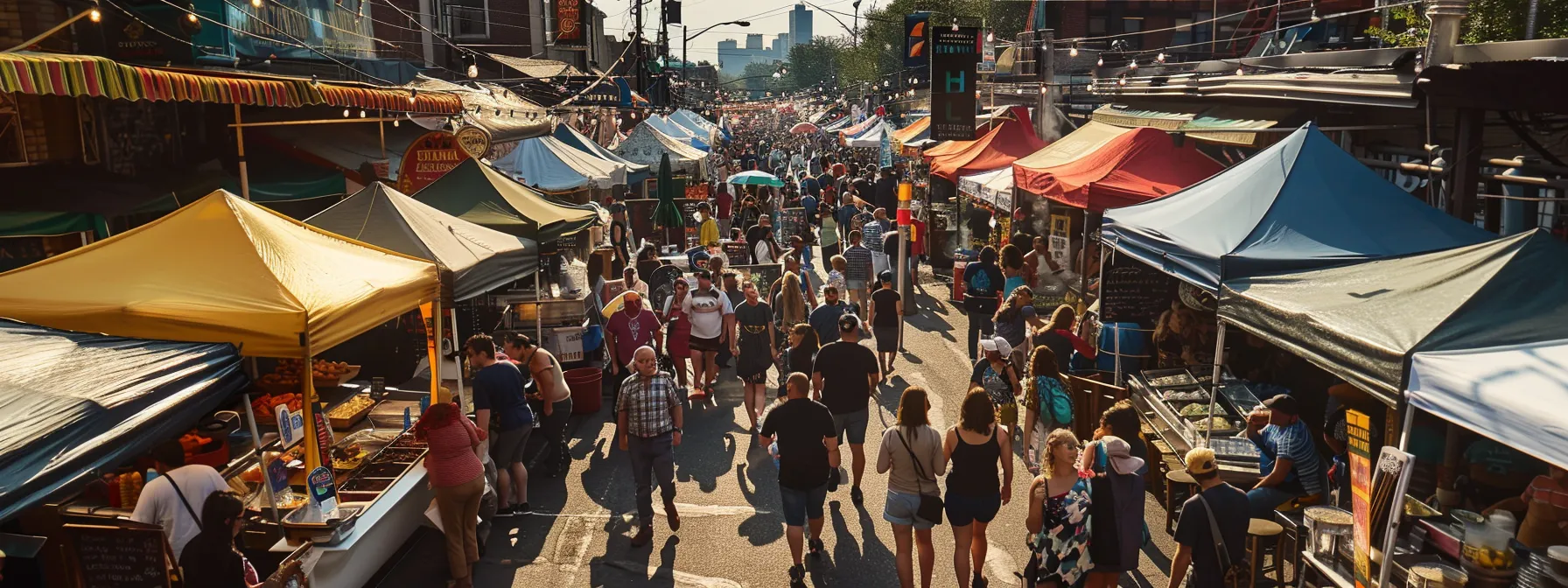
New York City’s kaleidoscope of cultures offers student groups a spectacular array of educational experiences. They can dive into colorful festivals in Chinatown and Little Italy, exploring historical traditions and engaging narratives. Queens’ tapestry of global flavors invites students on a culinary journey, enhancing their understanding of cultural diversity. Museums like the Jewish Museum provide windows into specific cultural heritages, while tailored workshops and language exchanges deepen cultural competence. Additionally, students may participate in local community projects, witnessing the real-world impact of collaboration in diverse neighborhoods.
Experience Cultural Festivals in Chinatown and Little Italy
Chinatown and Little Italy are neighborhoods steeped in cultural history, offering school groups an exhilarating sensory and educational experience. During festivals like the Chinese New Year or the Feast of San Gennaro, students can observe traditional customs, participate in vibrant celebrations, and connect classroom lessons to real-world cultural expressions. These lively events provide a firsthand look at how cultural heritage is preserved and celebrated in an urban landscape, tying in perfectly with social studies and global history curriculums.
Teachers find these festivals to be an excellent opportunity for students to broaden their cultural horizons, all while enjoying the delicious flavors of authentic cuisine. Students gain an appetite for cultural understanding as they sample mooncakes or cannoli, illustrating the role food plays in cultural identity and celebration. Here’s what a school trip might include in Chinatown and Little Italy:
- Guided tours explaining the historical significance of each neighborhood
- Tasting sessions that allow students to explore the diverse culinary landscape
- Interactive workshops where students learn about traditional crafts and customs
Take a Culinary Tour of Queens’ International Food Scene
Queens, a melting pot of international cultures, offers student groups an unforgettable food tour that’s as educational as it is palate-pleasing. They discover the rich tapestry of global cuisine, turning each bite into a learning opportunity about the traditions, history, and people behind the dishes. This real-world exploration extends learning beyond the classroom, helping students make meaningful connections between food, culture, and the communities they visit.
Students on this culinary journey navigate a world map of flavors, from the savory cumin lamb skewers of a bustling Chinese night market to the delicate spices in an aromatic Indian curry. These gastronomic experiences provide educators with an avenue to discuss cultural diversity, migration’s influence on food, and the role of cuisine in community identity, enriching students’ perspectives on the world’s interconnectedness.
Visit Cultural Institutions Like the Jewish Museum
A journey to cultural institutions like the Jewish Museum in New York City allows student groups to unearth the rich tapestry of Jewish heritage. Through interactive exhibits and historical artifacts, they gain a deeper understanding of Jewish culture, its profound history, and the contributions of Jewish individuals to society and the arts. In essence, the museum provides a captivating educational experience that connects past to present, enriching students’ cultural knowledge and empathy.
While exploring the Jewish Museum, learners come face-to-face with an array of art, ceremonial objects, and poignant narratives that paint a vivid portrait of Jewish tradition. This visit not only complements their social studies curriculum but also offers a vital perspective on the diversity that shapes the global community. Such meaningful encounters foster inclusive understanding, encouraging students to appreciate the mosaic of cultures that define New York City and beyond.
Participate in Cultural Workshops and Language Exchanges
Participating in cultural workshops allows students to engage directly with New York City’s diverse communities, fostering a genuine understanding of different heritages through hands-on activities. Whether creating traditional Korean paper lanterns or learning the basics of Capoeira, these workshops offer an interactive gateway to global cultures, enriching any school itinerary.
Language exchanges present an exciting challenge for students, giving them the chance to practice new linguistic skills with native speakers. This practical application of language learning strengthens students’ communication abilities and boosts their confidence, while also allowing for organic cultural exchange in one of the world’s most cosmopolitan cities.
Engage With Community Projects in Diverse Neighborhoods
Within the vibrant neighborhoods of New York City, student groups find unique opportunities to engage in community projects. These initiatives offer young learners a hands-on way to contribute to the fabric of diverse urban communities and understand the city’s social dynamics. Service learning in neighborhoods like the Bronx or Queens adds a rich layer to the NYC educational tour, fostering teamwork and a sense of civic responsibility.
Participation in these community projects goes beyond typical sightseeing; it allows students to interact with local residents and grasp the tangible impact of their efforts. Whether they’re planting a community garden or helping to paint a mural, students learn valuable life lessons about collaboration and empowerment:
- Developing community service skills
- Experiencing real-world social impact
- Understanding the importance of cultural respect and urban challenges
Frequently Asked Questions
What historical sites can students visit in New York City?
In New York City, student groups can marvel at historical sites like the Statue of Liberty, Ellis Island, and the 9/11 Memorial.
Are there interactive exhibits at NYC museums for students?
Absolutely, New York City museums offer a variety of interactive exhibits tailored for student engagement, encouraging hands-on learning across art, science, and history.
Can school groups see a Broadway show together?
Absolutely, school groups can experience the magic of Broadway together, with many shows offering special group rates and educational workshops.
Which iconic NYC landmarks are suited for educational tours?
New York City boasts educational icons like the Metropolitan Museum of Art, the American Museum of Natural History, and the Statue of Liberty, perfect for student tours.
How does New York City showcase cultural diversity to students?
New York City, with its mosaic of neighborhoods, museums, and culinary scenes, offers students vivid, hands-on experiences of global cultures in one vibrant urban canvas.
Conclusion
Educational trips to New York City offer students a rich tapestry of learning experiences, from delving into America’s history at landmarks like the Statue of Liberty to engaging with the vibrant arts scene on Broadway. The variety of museums and cultural institutions provide hands-on opportunities to explore everything from fine art to natural science, fostering enduring connections between classroom theory and real-world application. Through immersive workshops and community interactions, students develop a deeper cultural understanding and an appreciation for the city’s diverse society. Ultimately, these school excursions to NYC not only enhance academic knowledge but also equip students with insights and experiences that resonate far beyond their educational journey.

